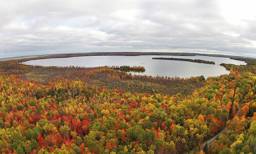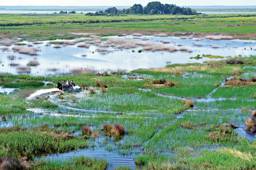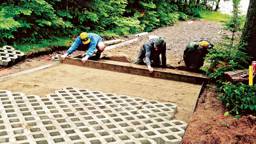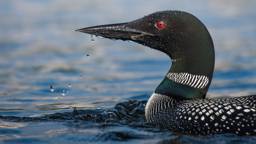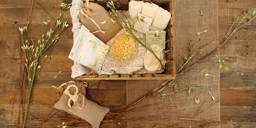Dale and Elaine Krueger are morning people. “One of our favorite parts of owning shoreland is this,” says Dale, with a sweeping gesture that encompasses mugs of coffee, a stilty-legged blue heron and the dawn breaking over Minnesota’s Lake Pokegama.
It’s no accident that animals, including an eagle and a pair of river otters, linger here. Although Lake Pokegama is ringed with homes and cabins, part of the Krueger’s shoreline looks like a mini-nature reserve. Willows, native grasses, wildflowers and strategically placed boulders anchor the soil and offer shelter for wildlife.
The couple put time, effort and thought (mixed with blood, sweat and tears) into creating a 4-foot wide buffer zone composed of native plants between their lawn and the lake.
Wise Investment
The Kruegers and an increasing number of their neighbors are discovering the wisdom of shore naturalization. Natural shorelines generate ecological, economic and recreational benefits according to lakescaping experts like Barb Liukkonen, Sea Grant extension agent and water resources education coordinator at the University of Minnesota.
A naturalized shoreline is created with native plants that are not only beautiful, but also functional and ecofriendly. Also, a naturalized shoreline does one job very well: It slows water down as it rushes to leave the land. Less and slower runoff reduces erosion and reduces the amount of algae-promoting nutrients entering the water from landlubberly things like fertilizer or grass clippings. The result — improved water clarity — is arguably the most compelling reason to let Mother Nature work her magic.
How compelling? Studies show that altering water clarity by one meter can impact property values by hundreds of dollars per frontage foot. Water clarity significantly affects prices paid for lakeshore properties.
Letting Nature Take Its Course
Naturalizing a shoreline may or may not save time (it depends on the property and the owner), but it will probably save ground. Wave action and runoff are less likely to chew away shores anchored by native species, which tend to develop deeper root systems than turf grass and ornamental plants. A buffer area of natural vegetation reduces time behind lawnmowers and the risk that mowing will cause a shore’s bank to collapse.
The ambiance of a naturalized shoreline is not lost on wildlife. A wet meadow area along the shore provides nesting and nourishment opportunities for songbirds and waterfowl. Natural conditions encourage fish, frogs, turtles, small mammals and butterflies to take up residence.
Some people erroneously believe that tall grasses and shrubs will attract pestilent species. The reality is that hangouts for dragonflies and other insect-eating animals serve to reduce a mosquito population. Taller grasses and shrubs at the water’s edge deter nuisance geese seeking a turf-grass lunch. Fearing the unseen, geese are reluctant to creep through vegetation that is over their heads.
Native plants can also give you more time for fun at the cabin. The watering hose, fertilizers and herbicides required for a lush lawn won’t be necessary here. With the exception of trimming shrubs and tree branches occasionally, your naturalized shoreline can become maintenance-free.
Compared to ornamental alternatives, native plants are more resistant to pests, better at attracting wildlife and more likely to survive. Native plants also provide color, texture and height variation throughout the growing season and often beyond.
Planting Makes Perfect
Careful planning is more likely to result in a successful planting. Here are some questions to ask before tearing up the sod:
1. What do I use the shoreline for?
2. How much of the shoreline do I want to naturalize?
3. Can I minimize erosion problems?
Consider the soil type, slope and light conditions when choosing plants. Remember to factor in how much of the area will be used, and whether you want to be able to view the lake over or through the new plantings. Making a sketch of your property might help your plotting and planning.
If you own waterfront property that hasn’t been developed yet, you can practice “shoreline editing” by selectively removing branches, shrubs and trees. Be careful when clearing the site to not leave fertile ground for invasive plants to conquer or erosion to steal. By minimizing the area you clear for docks and beaches, you will preserve vegetation that protects the shoreline.
One option for re-vegetation is to do nothing. When mowing, weeding and raking cease, native plants will likely reestablish themselves. If the shoreline has mucky or silty soil, seeds from plants that lived there in the past may still exist in the bottom sediments. Plants such as spike rush, sedges and arrowhead are particularly keen on resurfacing once the grass is allowed to go to seed. An interesting array of native perennials likely buffered the shoreline long before you were born; let them reappear!
Getting Your Hands Dirty
If the goal is to establish particular species or to accelerate the evolution of a natural shoreline, get out the gardening gloves. Before manipulating your shoreline, be sure to familiarize yourself with and follow state regulations. Choose native plants that have been grown locally and ensure they are free from invasive species.
Shoreline re-vegetation is most likely to succeed in areas that are sheltered with little or moderate wave action, that have a stable water level during the growing season and that are flat.
Once upon a time, a lawn tended with fertilizers and herbicides spreading to the water’s edge was considered sublime. Perceptions have changed. This season, consider naturalizing your shoreline. According to the Kruegers, “It doesn’t get much more beautiful than this.”
Meet the Families
Here are some indigenous plant families your waterfront might want to become friendly with — but like some other large, extended families, there’s a black sheep or two you should avoid.
The Arrowheads (Alismataceae)
These graceful perennials are waterside conversation starters. They vary so much in form that botanists debate the number of species (between 10 and 100). If conditions change between years, the same plant can sport a whole new look. They thrive in shallow water. Their tubers should be planted in mud with water from 6 inches to a foot in depth.
The Water Lilies (Nymphaeaceae)
Classic and classy, our two native species of white water lily are widespread. One even smells as heavenly as it looks. Vivid yellow flowers sway above the frog-friendly leaves of about 10 other native species. The family’s grande dame, the American lotus, can grow to 3 feet high, live for 20 years and can be overbearing — so you may want to avoid that one.
The Loosestrifes (Lythraceae)
Steering clear of this family’s invasive “black sheep” (purple loosestrife), there are several species to welcome in your waters. With its pinkish-purple flowers, swamp loosestrife (or waterwillow) fairly dances on shoreland edges whereas tufted loosestrife’s yellow blooms wave merrily in summer breezes. Waterpurslane, another member of the family, reportedly has medicinal qualities.
The Irises (Iridaceae)
Several spectacular native iris species enjoy life best when rooted on shorelines. Since some native irises are rare and many are difficult to transplant, resist the temptation to collect plants from the wild. Even gathering seeds should be done in moderation. Native irises are available from commercial suppliers and seeds can be found through seed exchange programs. Iris rootstocks can irritate skin, and the yellow iris is invasive and shouldn’t be planted.
The Sedges (Cyperaceae)
This family includes classic sedges with their unique seedheads, and bulrushes with their elegantly slender stems. The family is tough, being able to withstand rough water and wildlife grazing. Well-known sedges from oceans away include the water chestnut (used in Asian cooking) and the papyrus sedge (which ancient Egyptians made into scrolls).
Be sure to check out your local laws regarding collecting. Contact your favorite nursery or closest university extension educators for more information about native plants.
Sharon Moen is Minnesota Sea Grant’s word warrior. Although she doesn’t own lakeshore, she loves native aquatic plants so much that she dug a water garden into her yard.



